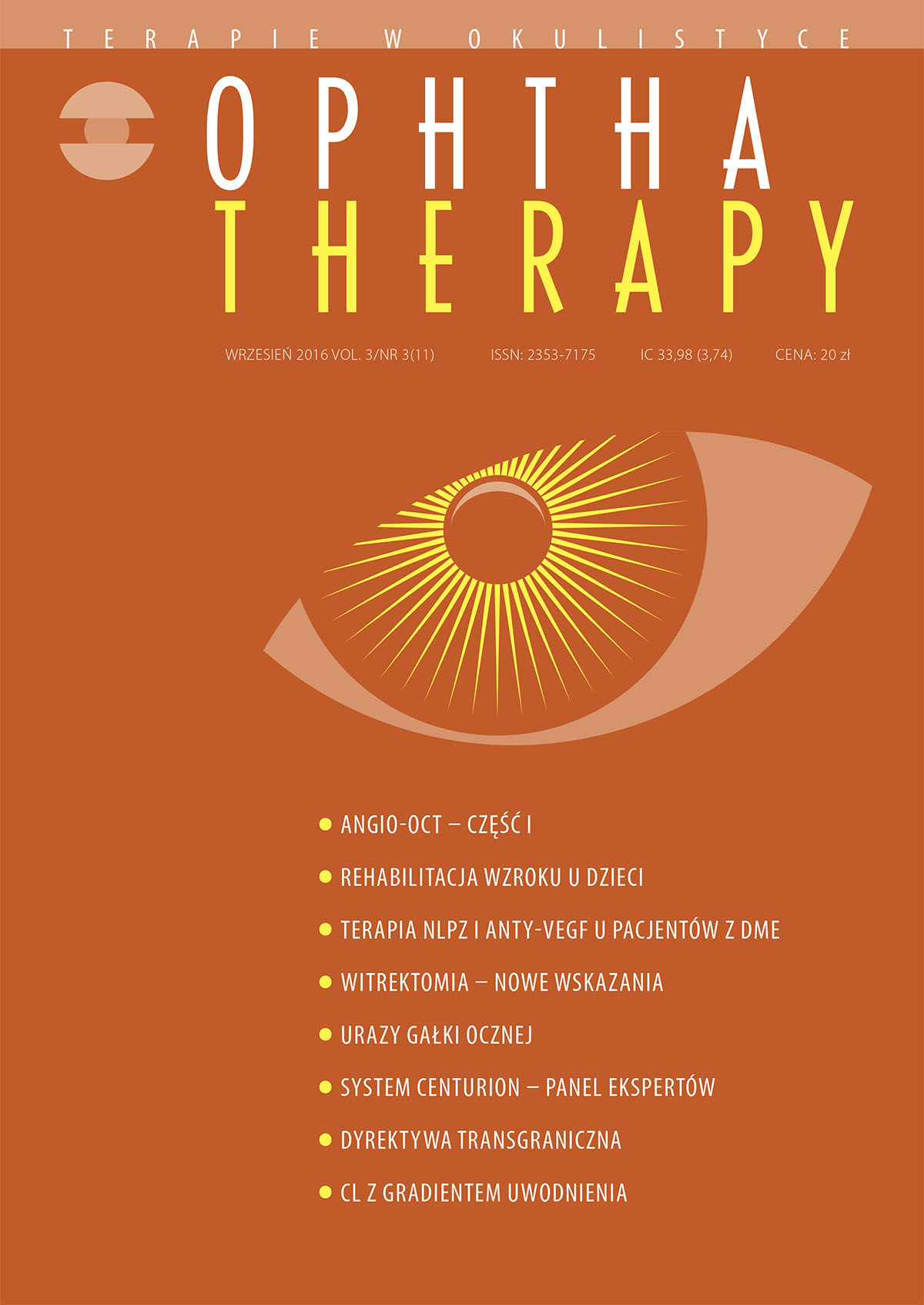The structure and properties of water gradient silicone hydrogel contact lenses
Main Article Content
Abstract
Recently, a significant rise in the share of one-day contact lenses in global sales has been noted. In order to increase the interest in daily disposable contact lenses, manufactures have tried a range of product improvements. Soft contact lens material delefilcon A (Dailies Total 1) with water gradient technology deserves special attention. Delefilcon A is composed of a silicone- hydrogel core, with a 33% water content, and an outer hydrogel layer with an 80% water content. A number of advanced biomicroscopic techniques enable an accurate analysis of the layered structure of delefilcon A.
Downloads
Article Details

This work is licensed under a Creative Commons Attribution-NonCommercial-NoDerivatives 4.0 International License.
Copyright: © Medical Education sp. z o.o. License allowing third parties to copy and redistribute the material in any medium or format and to remix, transform, and build upon the material, provided the original work is properly cited and states its license.
Address reprint requests to: Medical Education, Marcin Kuźma (marcin.kuzma@mededu.pl)
References
2. Nason RJ, Boshnick EL, Cannon WM et al. Multisite comparison of contact lens modalities. Daily disposable wear vs. conventional daily wear in successful contact lens wearers. J Am Optom Assoc. 1994; 65(11): 774-80.
3. Solomon OD, Freeman MI, Boshnick EL et al. A 3-year prospective study of the clinical performance of daily disposable contact lenses compared with frequent replacement and conventional daily wear contact lenses. Eye Contact Lens. 1995; 22(4): 250-7.
4. Cho P, Boost MV. Daily disposable lenses: The better alternative. Cont Lens Anterior Eye. 2013; 36: 4-12.
5. Hayes VY, Schnider CM, Veys J. An evaluation of 1-day disposable contact lens wear in a population of allergy sufferers. Cont Lens Anterior Eye. 2003; 26(2): 85-93.
6. Hickson-Curran S, Spyridon M, Hunt C et al. The use of daily disposable lenses in problematic reusable contact lens wearers. Cont Lens Anterior Eye. 2014; 37: 285-91.
7. Nicolson PC, Vogt J. Soft contact lens polymers: an evolution. Biomaterials. 2001; 22(24): 3273-83.
8. French K. Contact lens material properties. Part 1. Wettability. Optician. 2005; 230(6022): 20-8.
9. Sarac O, Gurdal C, Bostanci-Ceran B et al. Comparison of tear osmolarity and ocular comfort between daily disposable contact lenses: hilafilcon B hydrogel versus narafilcon A silicone hydrogel. Int Ophthalmol. 2012; 32: 229-33.
10. Hutter J. FDA Group V: Is a Single Grouping Sufficient to Describe SiHy Performance? http://www.siliconehydrogels.org/editorials/nov_07.asp.
11. Guryča V, Hobzová R, Přdný M et al. Surface morphology of contact lenses probed with microscopy techniques. CLAO J. 2007; 30: 215-222.
12. Qiu Y, Pruitt JD, Thekveli SJ et al. Silicone hydrogel lenses with water-rich surfaces. U.S. Patent Application Publication 2012: 1-10.
13. Pérez-Gómez I, Giles T. European survey of contact lens wearers and eye care professionals on satisfaction with a new water gradient daily disposable contact lens. Clinical Optometry. 2014; 6: 17-23.
14. Pruitt J, Qiu Y, Thekveli S et al. Surface characterization of a water gradient silicone hydrogel contact lens (delefilcon A). Invest Ophthalmol Vis Sci. 2012; 53(14): E-Abstract 6107.
15. Dursch TJ, Liu DE, Oh Y et al. Fluorescent solute-partitioning characterization of layered soft contact lenses. Acta Biomater 2015; 15: 48-54.
16. Krysztofiak K, Ciężar K, Kościński M. Raman imaging of layered soft contact lenses. J Appl Biomater Funct Mater. [in print]. https://doi.org/10.5301/jabfm.5000329.
17. Del Águila-Carrasco AJ, Domínguez-Vicent A, Pérez-Vives C, et. al. Assessment of modifications in thickness, curvatures, and volume upon the cornea caused by disposable soft contact lens wear. Eur J Ophthalmol. 2015; 25(5): 385-90.
18. Wolffsohn JS, Mroczkowska S, Hunt OA, et. al. Crossover Evaluation of Silicone Hydrogel Daily Disposable Contact Lenses. Optom Vis Sci. 2015; 92(11): 1063-8.

